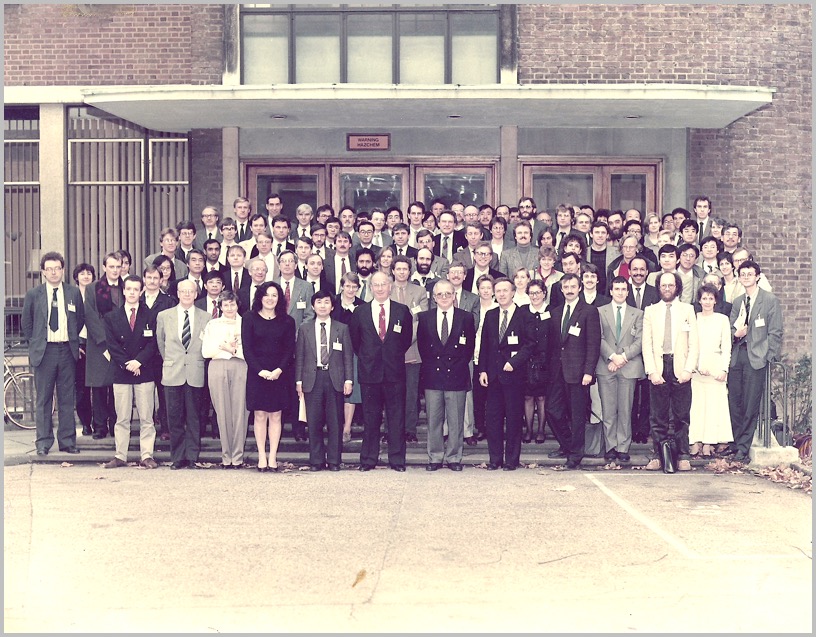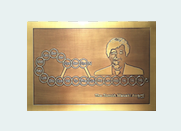Conference History
By David J. Webb and Donald E. Kohan
(2005)
The First William Harvey Workshop on Endothelin in London, UK, December 6, 1988.
Front row center: Tomoh Masaki, Sir John Vane (Conference Chair), and Paul M. Vanhoutte.
Photograph courtesy of Mick Dashwood, London, UK
With an increasing focus through the 1980s on the central role of the endothelium in regulation of vascular function, and the recent identification of nitric oxide in June 1987 as the endothelium-derived relaxing factor (EDRF), the hunt for an opposing endothelium-derived constricting factor (EDCF) was very definitely on. This was a competitive attack by a number of research groups across the world, with evidence emerging that one likely candidate was a powerful endothelium-derived peptide. The eventual prize for discovering the first peptidergic EDCF went to Masashi Yanagisawa and his colleagues from the Institute of Basic Medical Sciences, at the University of Tsukuba, Japan, led by Katsutoshi Goto and Tomoh Masaki. Their landmark publication of the structure, pharmacology and molecular biology of endothelin in the 31st March 1988 edition of Nature [1], was both a well-kept secret and a tour-de-force in science terms, giving an indication of the future power of molecular medicine. Dr Yanagisawa presented his work – his PhD thesis! – to great acclaim at the meeting of the International Society of Hypertension in Kyoto in the summer of 1988.
The first international conference ran at St Bartholomew's Hospital in London, England, as the ‘First William Harvey Workshop on Endothelin' (ET-1) in December of 1988. The Proceedings, edited by Sir John Vane, Renia Botting and Tomoh Masaki, were later published in the Journal of Cardiovascular Pharmacology in 1989. The second meeting, now known as the Second International Conference on Endothelin (ET-2), was held two years later, in December 1990, in Tsukuba, Japan hosted by Tomoh Masaki, at which time the cloning of the two receptors for endothelin, ETA and ETB was first revealed immediately before their publication in Nature [2,3]. By then it was also clear that Roche, with a team led by Martine Clozel, had identified antagonists to endothelin around the time of its discovery, and these, as well as discovery of informative small antagonist peptides, such as BQ-123, created great excitement, and were published subsequently in the Proceedings [4] and in Nature [5]. The meetings have subsequently fallen into a two-yearly cycle of rotation between Europe, North America and Japan, with ET-3 held in 1993 in Houston, Texas, hosted by Paul M. Vanhoutte, ET-4 in 1995 in London, England, again hosted by Sir John Vane, ET-5 in 1997 in Kyoto, Japan, back-to-back with the International Nitric Oxide Meeting and hosted by Tomoh Masaki, ET-6 in 1999 in Montreal hosted by Pedro d'Orléans-Juste and Duncan Stewart, ET-7 in 2001 in Edinburgh, Scotland, hosted by David Webb, ET-8 in 2003 back in Tsukuba hosted by Katsutoshi Goto, ET-9 was held in 2005 in Park City, Utah, hosted by Donald Kohan, ET-10 was held in Bergamo, Italy, in 2007 hosted by Ariela Benigni, ET-11 was again held in Montreal in 2009 hosted by Pedro d'Orléans-Juste and David Pollock, ET-12 was held in 2011 in Cambridge, UK, hosted by Matthias Barton and Anthony Davenport, ET-13 was held in 2013 in Tokyo, Japan, hosted by Noriaki Emoto and Takashi Miyauchi, and ET-14 was held in 2015 in Savannah, GA, U.S.A., and hosted by Adviye Ergul, Anil Gulati, and David Pollock. In 2017, ET-15 was held for the first time in Eastern Europe in a former communist country, in the historic city of Prague and chaired by Ivana Vaneckova and John Pernow. In 2019, ET-16 was held the city of Kobe, chaired by Noriaki Emoto and Bambang Widyantoro. ET-17 was held as an online conference due to the restrictions imposed by the SARS-2 pandemic and was chaired by Michelle Gumz and Kelly Hyndman. ET-18 was held in 2023 as the first in-person endothelin meeting in 4 years after the SARS-2 pandemic in the beautiful historic city of Rome, Italy, and chaired by Carmine Cardillo, Franchesca Schinzari, and Bean Dhaun. The new science unveiled at these meetings has been highlighted in the meeting Proceedings published in the Journal of Cardiovascular Pharmacology, Clinical Science, Experimental Biology and Medicine, the Canadian Journal of Physiology and Pharmacology, and Life Sciences, as well as in reviews published in the American Journal of Physiology, the British Journal of Pharmacology, Experimental Biology and Medicine, Life Sciences, and Trends in Pharmacological Sciences (TiPS),
The last meetings have all been well attended, with 150-300 delegates, and generated well-cited published Proceedings (ENDOTHELIN I - ENDOTHELIN XVII). The meetings themselves have been highly collegial and shown the very best of what can be achieved through an effective collaboration between basic and clinical scientists, and between academia and industry, in the organization and support for the meetings, and the discussion and science generated. In 2001, at the Edinburgh meeting, Martine Clozel announced the award by the U.S. Food & Drug Administration for a license for bosentan as first endothelin receptor antagonist for the treatment for pulmonary arterial hypertension. After disappointments in chronic heart failure, this came as a major boost for the field, which has now generated more than 30,000 papers, and a growing body of clinical work, driven by high quality basic science. It is still widely anticipated there are major opportunities for the development of endothelin antagonists as new medicines for cardiovascular and renal disease, some forms of cancer, pain control, and other areas.
1. Yanagisawa M, Kurihara H, Kimura S, Tomobe Y, Kobayashi M, Mitsui Y, Yazaki Y, Goto K, Masaki T.
A novel potent vasoconstrictor peptide produced by vascular endothelial cells
Nature 1988;332:411-5.
2. Arai H, Hori S, Aramori I, Ohkubo H, Nakanishi S.
Cloning and expression of a cDNA encoding an endothelin receptor.
Nature 1990;348:730-2.
3. Sakurai T, Yanagisawa M, Takuwa Y, Miyazaki H, Kimura S, Goto K, Masaki T.
Cloning of a cDNA encoding a non-isopeptide-selective subtype of the endothelin receptor.
Nature 1990;348:732-5.
4. Ihara M, Ishikawa K, Fukuroda T, Saeki T, Funabashi K, Fukami T, Suda H, Yano M.
In vitro biological profile of a highly potent novel endothelin (ET) antagonist BQ-123 selective for the ETA receptor.
J Cardiovasc Pharmacol 1992;20 Suppl 12:S11-4.
5. Clozel M, Breu V, Burri K, Cassal JM, Fischli W, Gray GA, Hirth G, Loffler BM, Muller M, Neidhart W, Ramuz H
Pathophysiological role of endothelin revealed by the first orally active endothelin receptor antagonist.
Nature 1993;365:759-61.
